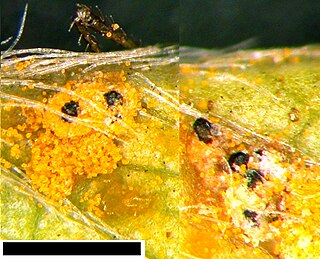
Eurotiomycetes is a large class of ascomycetes with cleistothecial ascocarps within the subphylum Pezizomycotina, currently containing around 3810 species according to the Catalogue of Life. It is the third largest lichenized class, with more than 1200 lichen species that are mostly bitunicate in the formation of asci. It contains most of the fungi previously known morphologically as "Plectomycetes".

The Hypocreales are an order of fungi within the class Sordariomycetes. In 2008, it was estimated that it contained some 237 genera, and 2647 species in seven families. Since then, a considerable number of further taxa have been identified, including an additional family, the Stachybotryaceae. Wijayawardene et al. in 2020 added more families and genera to the order. According to the Catalog of Life, As of April 2021 the Hypocreales contains 6 families, 137 genera, and 1411 species. Hyde et al. (2020a) listed 14 families under Hypocreales, while, Wijayawardene et al. (2022) accepted 15 families in the order, where Cylindriaceae was additionally added. Earlier, Hyde et al. (2020a) had placed Cylindriaceae in class Xylariomycetidae. Samarakoon et al. (2022) agreed. Hence, Cylindriaceae should have been excluded from Hypocreales and placed in Xylariomycetidae. Xiao et al. (2022) recently introduced a new family Polycephalomycetaceae to Hypocreales.

The Nectriaceae comprise a family of fungi in the order Hypocreales. It was circumscribed by brothers Charles and Louis René Tulasne in 1865. In 2020, an Outline of fungi was produced and listed 70 genera and about 1,336 species.

Pleosporaceae is a family of sac fungi. They are pathogenic to humans or saprobic on woody and dead herbaceous stems or leaves.

The Botryosphaeriaceae are a family of sac fungi (Ascomycetes), which is the type representative of the order Botryosphaeriales. According to a 2008 estimate, the family contains 26 genera and over 1500 species. Members of this order include notable plant pathogens.

The Botryosphaeriales are an order of sac fungi (Ascomycetes), placed under class Dothideomycetes. Some species are parasites, causing leaf spot, plant rot, die-back or cankers, but they can also be saprophytes or endophytes. They occur world-wide on many hosts. For example, in China, infections related to Botryosphaeriales have been recorded on numerous hosts such as grapes, Caragana arborescens,Cercis chinensis, Eucalyptus, Chinese hackberry, blueberry, forest trees, and various other woody hosts.

The Phaeosphaeriaceae are a family of fungi in the order Pleosporales. Species in the family have a cosmopolitan distribution, and are generally nectrotrophic or saprobic on a wide range of plants.

Herpotrichiellaceae is a family of ascomycetous fungi within the order Chaetothyriales and within the class Eurotiomycetes. It contains 16 genera and about 270 species. The type genus of the family, Herpotrichiella, is now synonymous with Capronia.
Camarosporula is a genus of fungi in the class Dothideomycetes. This is a monotypic genus, consisting of the single species Camarosporula persooniae. It has the Teleomorph synonym of Anthracostroma persooniae.
The Planistromellaceae are a family of fungi, with in the class of Botryosphaeriales.
Leptosillia is a fungal genus in the monogeneric family of Leptosilliaceae. The genus was circumscribed by Austrian mycologist Franz Xaver Rudolf von Höhnel in 1928. As the genus name suggests, Leptosillia was considered to be closely related to the diaporthalean genus of Sillia.
The Niessliaceae are a family of fungi in the phylum Ascomycota, class Sordariomycetes. The family was updated in 2020.

The Leptosphaeriaceae are a family of fungi in the order Pleosporales. The family was circumscribed by mycologist Margaret E. Barr in 1987. According to the Dictionary of the Fungi, the family contained 8 genera and 302 species. The family has a widespread distribution, but is especially prevalent in temperate regions. Species are either saprobic or grow as nectrotrophs on the stems or leaves of plants.
Togniniaceae is family of fungi in the order Togniniales.

Rhinocladiella is a genus of fungi in the family Herpotrichiellaceae. It has 17 species. The genus was circumscribed by Swedish botanist John Axel Nannfeldt in 1934 with R. atrovirens as the type species.
Xenospadicoidaceae is a family of fungus first described in 2017. Its parent taxon, Xenospadicoidales, is a monotypic order in the class Sordariomycetes.
Pseudodactylaria are a genus of fungi, within the monotypic family PseudodactylariaceaeCrous, and within the monotypic order PseudodactylarialesCrous, within the class Sordariomycetes. They are saprobic on plants in freshwater or terrestrial habitats.
Pararamichloridium is a genus of fungi in the monotypic family Pararamichloridiaceae and within the monotypic order of Pararamichloridiales and also in the subclass Hypocreomycetidae. They are saprobic on wood in terrestrial and freshwater habitats.

Neocamarosporium is a genus of ascomycete fungi, as accepted by Wijayawardene et al. 2020. The species are typically halotolerant, being commonly found in saline environments like in saline water, hypersaline soils and especially in association with halophytes.
Falcocladium is a genus of fungi, within the monotypic family FalcocladiaceaeSomrith., E.B.G. Jones & K.L. Pang, and within the monotypic order FalcocladialesR.H. Perera, Maharachch., Somrith., Suetrong & K.D. Hyde, within the class Dothideomycetes. They are saprobic on leaf litter, including the leaves of Eucalyptus grandis and Eucalyptus camaldulensis in tropical and terrestrial habitats.











